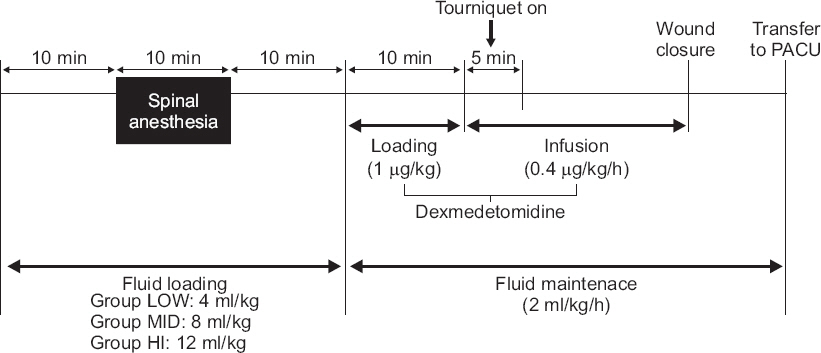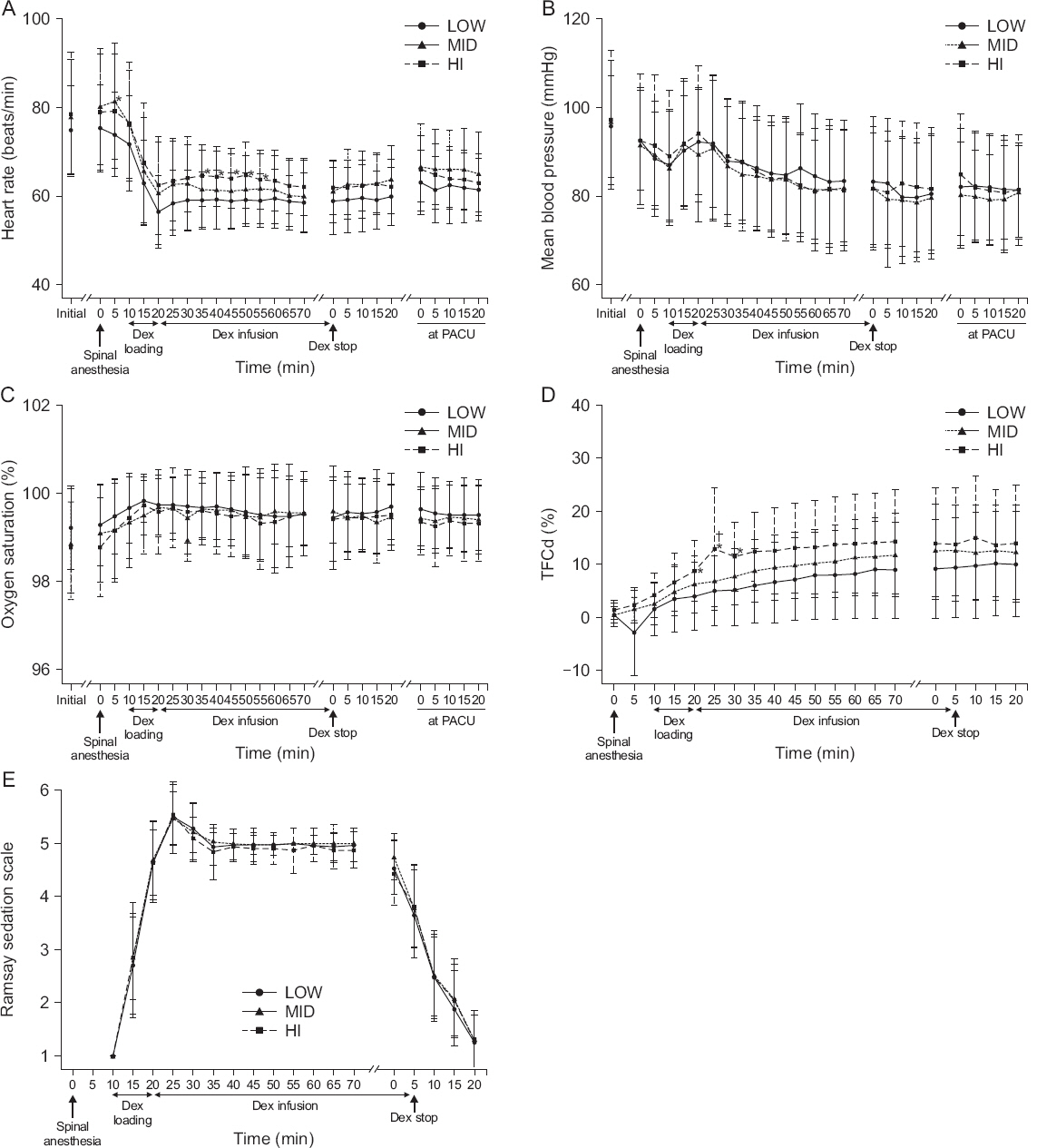Anesth Pain Med.
2019 Jan;14(1):19-28. 10.17085/apm.2019.14.1.19.
Fluid loading during spinal anesthesia can reduce bradycardia after intravenous dexmedetomidine infusion
- Affiliations
-
- 1Department of Anesthesiology and Pain Medicine, Busan Paik Hospital, Inje University College of Medicine. anespc@naver.com
- 2Paik Institute for Clinical Research, Inje University College of Medicine, Busan, Korea.
- KMID: 2434194
- DOI: http://doi.org/10.17085/apm.2019.14.1.19
Abstract
- BACKGROUND
Dexmedetomidine has been widely used during spinal anesthesia to provide sedation. However, dexmedetomidine frequently causes significant bradycardia. This study was designed to evaluate whether fluid loading could reduce the incidence of bradycardia after intravenous dexmedetomidine infusion in patients under spinal anesthesia.
METHODS
A total of 99 patients, 18 to 65 years of age, with American Society of Anesthesiologists physical status 1 or 2, who were scheduled for elective total knee replacement or internal fixation of lower leg fracture under spinal anesthesia were enrolled. The patients were randomly assigned into one of the three groups, and fluid was loaded as follows: group LOW - 4 ml/kg, group MID - 8 ml/kg, and group HI - 12 ml/kg. After fluid loading and spinal anesthesia, dexmedetomidine was infused as follows: 1 μg/kg of loading dose for 10 minutes, thereafter continuous infusion at 0.4 μg/kg/h.
RESULTS
The heart rate of group HI was significantly higher than that of group LOW (P = 0.049). The dosage of atropine administration was significantly lower in group HI than in group LOW (P = 0.003). The change in thoracic fluid contents was significantly higher in group HI than in group LOW (P = 0.018).
CONCLUSIONS
Fluid loading during spinal anesthesia can reduce the incidence and extent of bradycardia after intravenous dexmedetomidine infusion.
MeSH Terms
Figure
Reference
-
1. Wu CL, Naqibuddin M, Fleisher LA. Measurement of patient satisfaction as an outcome of regional anesthesia and analgesia: a systematic review. Reg Anesth Pain Med. 2001; 26:196–208. DOI: 10.1053/rapm.2001.22257. PMID: 11359218.2. Kim DS, Na HS, Lee JH, Shin YD, Shim JK, Shin HW, et al. Current clinical application of dexmedetomidine for sedation and anesthesia. Anesth Pain Med. 2017; 12:306–19. DOI: 10.17085/apm.2017.12.4.306.3. De Andrés J, Valia JC, Gil A, Bolinches R. Predictors of patient satisfaction with regional anesthesia. Reg Anesth. 1995; 20:498–505. PMID: 8608068.4. Reddy VS, Shaik NA, Donthu B, Reddy Sannala VK, Jangam V. Intravenous dexmedetomidine versus clonidine for prolongation of bupivacaine spinal anesthesia and analgesia: a randomized double-blind study. J Anaesthesiol Clin Pharmacol. 2013; 29:342–7. DOI: 10.4103/0970-9185.117101. PMCID: PMC3788233.5. Abdallah FW, Abrishami A, Brull R. The facilitatory effects of intravenous dexmedetomidine on the duration of spinal anesthesia: a systematic review and meta-analysis. Anesth Analg. 2013; 117:271–8. DOI: 10.1213/ANE.0b013e318290c566. PMID: 23632057.6. Dinesh CN, Sai Tej NA, Yatish B, Pujari VS, Mohan Kumar RM, Mohan CV. Effects of intravenous dexmedetomidine on hyperbaric bupivacaine spinal anesthesia: a randomized study. Saudi J Anaesth. 2014; 8:202–8. DOI: 10.4103/1658-354X.130719. PMID: 24843333. PMCID: PMC4024677.7. Elcicek K, Tekin M, Kati I. The effects of intravenous dexmedetomidine on spinal hyperbaric ropivacaine anesthesia. J Anesth. 2010; 24:544–8. DOI: 10.1007/s00540-010-0939-9. PMID: 20467879.8. Hong JY, Kim WO, Yoon Y, Choi Y, Kim SH, Kil HK. Effects of intravenous dexmedetomidine on low-dose bupivacaine spinal anaesthesia in elderly patients. Acta Anaesthesiol Scand. 2012; 56:382–7. DOI: 10.1111/j.1399-6576.2011.02614.x. PMID: 22220945.9. Jung SH, Lee SK, Lim KJ, Park EY, Kang MH, Lee JM, et al. The effects of single-dose intravenous dexmedetomidine on hyperbaric bupivacaine spinal anesthesia. J Anesth. 2013; 27:380–4. DOI: 10.1007/s00540-012-1541-0. PMID: 23307164.10. Lee MH, Ko JH, Kim EM, Cheung MH, Choi YR, Choi EM. The effects of intravenous dexmedetomidine on spinal anesthesia: comparision of different dose of dexmedetomidine. Korean J Anesthesiol. 2014; 67:252–7. DOI: 10.4097/kjae.2014.67.4.252. PMID: 25368783. PMCID: PMC4216787.11. Al-Mustafa MM, Badran IZ, Abu-Ali HM, Al-Barazangi BA, Massad IM, Al-Ghanem SM. Intravenous dexmedetomidine prolongs bupivacaine spinal analgesia. Middle East J Anaesthesiol. 2009; 20:225–31. PMID: 19583070.12. Tekin M, Kati I, Tomak Y, Kisli E. Effect of dexmedetomidine IV on the duration of spinal anesthesia with prilocaine: a double-blind, prospective study in adult surgical patients. Curr Ther Res Clin Exp. 2007; 68:313–24. DOI: 10.1016/j.curtheres.2007.10.006. PMID: 24692763. PMCID: PMC3969905.13. Crystal GJ, Salem MR. The Bainbridge and the “reverse” Bainbridge reflexes: history, physiology, and clinical relevance. Anesth Analg. 2012; 114:520–32. DOI: 10.1213/ANE.0b013e3182312e21. PMID: 21965361.14. Greene N. Preganglionic sympathetic blockade in man: a study of spinal anesthesia. The Torsten Gordh lecture 1980. Acta Anaesthesiol Scand. 1981; 25:463–9. DOI: 10.1111/j.1399-6576.1981.tb01688.x. PMID: 7051728.15. Ramsay MA, Savege TM, Simpson BR, Goodwin R. Controlled sedation with alphaxalone-alphadolone. Br Med J. 1974; 2:656–9. DOI: 10.1136/bmj.2.5920.656. PMID: 4835444. PMCID: PMC1613102.16. Whizar-Lugo V, Gómez-Ramírez IA, Cisneros-Corral R, Martínez-Gallegos N. Intravenous dexmedetomidine vs. intravenous clonidine to prolong bupivacaine spinal anesthesia. A double blind study. Anest en Mexico. 2007; 19:143–6.17. Kaur M, Singh PM. Current role of dexmedetomidine in clinical anesthesia and intensive care. Anesth Essays Res. 2011; 5:128–33. DOI: 10.4103/0259-1162.94750. PMID: 25885374. PMCID: PMC4173414.18. Mittal G, Gupta K, Katyal S, Kaushal S. Randomised double-blind comparative study of dexmedetomidine and tramadol for post-spinal anaesthesia shivering. Indian J Anaesth. 2014; 58:257–62. DOI: 10.4103/0019-5049.135031. PMID: 25024466. PMCID: PMC4090989.19. Hsu YW, Cortinez LI, Robertson KM, Keifer JC, Sum-Ping ST, Moretti EW, et al. Dexmedetomidine pharmacodynamics: part I: crossover comparison of the respiratory effects of dexmedetomidine and remifentanil in healthy volunteers. Anesthesiology. 2004; 101:1066–76. DOI: 10.1097/00000542-200411000-00005. PMID: 15505441.20. Mason KP, Zurakowski D, Zgleszewski S, Prescilla R, Fontaine PJ, Dinardo JA. Incidence and predictors of hypertension during high-dose dexmedetomidine sedation for pediatric MRI. Paediatr Anaesth. 2010; 20:516–23. DOI: 10.1111/j.1460-9592.2010.03299.x. PMID: 20412458.21. Sudheesh K, Harsoor S. Dexmedetomidine in anaesthesia practice: a wonder drug? Indian J Anaesth. 2011; 55:323–4. DOI: 10.4103/0019-5049.84824. PMID: 22013245. PMCID: PMC3190503.22. Sancetta SM, Lynn RB, Simeone FA, Scott RW. Studies of hemodynamic changes in humans following induction of low and high spinal anesthesia: I. general considerations of the problem. The changes in cardiac output, brachial artery pressure, peripheral and pulmonary oxygen contents and peripheral blood flows induced by spinal anesthesia in humans not undergoing surgery. Circulation. 1952; 6:550–71. DOI: 10.1161/01.CIR.6.4.559.23. Carpenter RL, Caplan RA, Brown DL, Stephenson C, Wu R. Incidence and risk factors for side effects of spinal anesthesia. Anesthesiology. 1992; 76:906–16. DOI: 10.1097/00000542-199206000-00006. PMID: 1599111.24. Baron JF, Decaux-Jacolot A, Edouard A, Berdeaux A, Samii K. Influence of venous return on baroreflex control of heart rate during lumbar epidural anesthesia in humans. Anesthesiology. 1986; 64:188–93. DOI: 10.1097/00000542-198602000-00010. PMID: 3080922.25. Kossari N, Hufnagel G, Squara P. Bioreactance: a new tool for cardiac output and thoracic fluid content monitoring during hemodialysis. Hemodial Int. 2009; 13:512–7. DOI: 10.1111/j.1542-4758.2009.00386.x. PMID: 19758300.26. Hamed AMS, Talaat SM. Effect of intravenous versus intrathecal low-dose dexmedetomidine on spinal block in lower limb orthopedic surgery. Ain-Shams J Anaesthesiol. 2014; 7:205–210. DOI: 10.4103/1687-7934.133442.27. Jackson R, Reid JA, Thorburn J. Volume preloading is not essential to prevent spinal-induced hypotension at caesarean section. Br J Anaesth. 1995; 75:262–5. DOI: 10.1093/bja/75.3.262. PMID: 7547039.28. Ben-David B, Frankel R, Arzumonov T, Marchevsky Y, Volpin G. Minidose bupivacaine-fentanyl spinal anesthesia for surgical repair of hip fracture in the aged. Anesthesiology. 2000; 92:6–10. DOI: 10.1097/00000542-200001000-00007. PMID: 10638892.29. Bajwa SJ, Kulshrestha A, Jindal R. Co-loading or pre-loading for prevention of hypotension after spinal anaesthesia!A therapeutic dilemma. Anesth Essays Res. 2013; 7:155–9. DOI: 10.4103/0259-1162.118943. PMCID: 25885825. PMCID: PMC4173526.30. Ingersoll-Weng E, Manecke GR Jr, Thistlethwaite PA. Dexmedetomidine and cardiac arrest. Anesthesiology. 2004; 100:738–9. DOI: 10.1097/00000542-200403000-00040. PMID: 15108994.
- Full Text Links
- Actions
-
Cited
- CITED
-
- Close
- Share
- Similar articles
-
- Laparoscopic appendectomy under spinal anesthesia with dexmedetomidine infusion
- Comparison of several dosing schedules of intravenous dexmedetomidine in elderly patients under spinal anesthesia
- Dexmedetomidine combined with midazolam vs. dexmedetomidine alone for sedation during spinal anesthesia
- Optimal dose of dexmedetomidine for sedation during spinal anesthesia
- Development of severe junctional bradycardia after dexmedetomidine infusion in a polypharmacy patient: a case report and literature review




